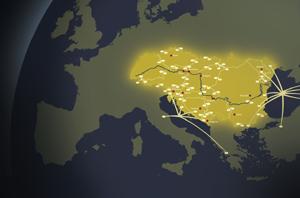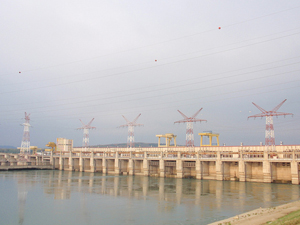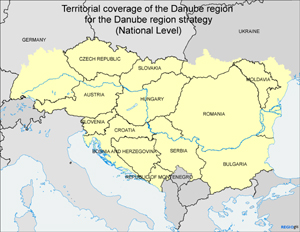The Danube region - a future European Energy Corridor?
on
The Danube region – a future European Energy Corridor?
Last December the European Commission adopted the EU Strategy for the Danube Region (EUSDR). Energy is one of the themes of the new Strategy. While EUSDR mentions some energy topics such as renewable energy and energy efficiency, other significant pieces of the regional energy puzzle are absent – an integrated regional energy infrastructure plan, the energy poverty challenge, and the regional nuclear energy sector, among other things. More work should also be done to create links to other regional and EU organizations, programs and policy instruments with relevance to the energy sector and to convince the participating countries that regional energy cooperation is critical to the Strategy’s success.
 |
| European Territorial Cooperation (click to enlarge) |
Encouraged by the early success of the EU Strategy for the Baltic Sea Region, adopted in 2009, the European Council last year asked the European Commission to develop a similar macro-regional strategic proposal for the Danube region. The focus region was defined as the Danube River’s basin, so that 14 countries are included: Germany, the Czech Republic, Austria, Slovakia, Hungary, Slovenia, Croatia, Serbia, Bosnia and Herzegovina, Montenegro, Romania, Bulgaria, the Republic of Moldova and Ukraine.
A public consultation was launched in February 2010 to give all the interested stakeholders – national governments, local authorities, academia, NGOs, the general public – the chance to define and defend their positions regarding the Strategy. A series of information and public consultation events were held in the following months in Ulm (Germany), Budapest (Hungary), Vienna (Austria), Bratislava (Slovakia), Ruse (Bulgaria) and Constanta (Romania). After the public consultation stage, the European Commission started preparing the Strategy, while on the political front, the heads of state of the participating countries met at the Danube Summit in Bucharest on 8 November 2010. In the summit Declaration of this event, they re-iterate their ‘strong support towards finalisation, adoption and implementation of the EU Strategy for the Danube Region’. Finally, the EU Strategy for the Danube Region (EUSDR), including a Communication and an Action Plan, was adopted by the European Commission on 8 December 2010.
Energy and the New Strategy
In the EUSDR, the Commission recognizes the importance of the Danube region: ‘With over 100 million people, and a fifth of EU surface, the area is vital for Europe’. Like the strategy for the Baltic Sea Region, EUSDR was developed to make better use of the existing EU legislation, financing programs and cooperation structures in order to create a balanced and sustainable development framework for the region. ‘No new EU funds, no new EU legislation, no new EU structures’ is the summary of these principles in the strategy’s Communication document.
The Strategy is built around four main pillars: improving connectivity in the Danube Region; protecting the region’s environment; building prosperity; and strengthening the local governance systems and improving public security. As a critical part of any economic and social system, energy has its place in the strategy documents, i.e. the Communication and the Action Plan. The Communication document
| The new strategy can add value to the energy sector in the Danube region only by proposing an integrated vision |
Renewable energy action
The Action Plan complements the Communication document and is the “living” part of the Strategy, as it will be periodically updated. Its main objective is to link the four pillars and their Priority Areas identified by the Communication to specific actions and concrete projects that must be implemented by the participating countries. Actions and projects must have an impact on the macro-region and should be realistic, coherent and mutually supportive.
The energy actions and projects are proposed under several headings – energy infrastructure, energy markets, energy efficiency and renewable energy – all of them concentrated in the second Priority Area – ‘to encourage more sustainable energy’ – of the connectivity pillar. In terms of energy infrastructure and markets, the Action Plan has some realistic proposals:
- to increase the gas storage capacities in the region
- to implement the interconnector and pipeline projects already supported in the Commission’s TEN-E (Trans European Network) policy and in the European Energy Programme for Recovery in
the regionAlthough developing the nuclear energy sector was mentioned as an action by some countries in their national contribution documents, it was not addressed in the final package - to finalise the feasibility study for the New Europe Transmission System (NETS) and implement this regional network integration initiative
- to tap potential synergies between the new Strategy and the Energy Community aimed at creating an integrated regional energy market
In the renewable energy and energy efficiency fields, the Action Plan is laudably proposing the development of a Danube Region Renewable Energy Action Plan, as well as a comprehensive plan for the sustainable development of the hydropower generation potential of the Danube River and its tributaries. Local renewable energy sources should be used to increase the energy autonomy in the region and the Energy Community contracting parties and observers should be encouraged to adopt the Renewable Energy Directive. Finally, rehabilitation of the district heating systems and more combined heat and power capacity in the region should be pursued to create regional networking and cooperation opportunities in energy efficiency and renewable energy.
Missing Links
Although the EUSDR documents recognize the importance of energy as a supranational dimension that is vital for the sustainable development of the Danube region, important parts of the energy value chain are not discussed. As energy projects have long planning cycles and investment lead times, the new strategy can add value to the energy sector in the Danube region only by proposing an integrated vision for this sector, ranging from primary energy sources and energy infrastructure to distribution and efficient energy use.
 |
| Hydropower Plant on the Danube, between Serbia and Romania (Photo: Andra Moclinda-Bucuta) |
Transition plans for the regional fossil fuel sector also have to be integrated in the Danube strategy, especially for the most polluting and unsustainable fuels, as some of the participating countries still have relatively significant segments of the population involved in these industrial sectors. Coal mining in Bulgaria, Romania, Serbia, and so on, is probably the best example. If these plans are already included in other EU policy instruments, they should be linked to EUSDR. In the same context, EUSDR should assess the place of the domestic conventional oil and gas industry in the Danube region and define what the EU’s approach is to the unconventional domestic hydrocarbon resources of the region, such as shale oil, shale gas and coal-bed methane (CBM).
Coal and oil
As regards energy transportation infrastructure, the Action Plan does not propose an integrated approach, relying instead on the future Energy Security and Infrastructure Instrument which has been proposed as a replacement of the TEN-E plan and the national 10-year network development plans.
| One final issue that should be linked to the power and heat generation portion of the energy value chain and included in the Action Plan is the regional potential for pilot projects in carbon capture and storage |
As much as 60-70% of the existing power and heat generation assets, especially in the Lower Danube region, use polluting fuels such as coal and oil and have declining generation yields as they are well past their design life. Therefore, the proposed Danube Region Renewable Energy Action Plan and the hydropower development action plan should be complemented with a regional transition and re-development plan for the existing power generation assets. It should be noted that large areas in the Danube region, especially along the Lower Danube and in the Danube Delta, are mostly rural and isolated from the power and heat networks. Sometimes they cannot be connected to these networks in a sustainable way if damage to sensitive natural environments is to be avoided. For this reason, alternative, decentralised and local power and heat generation approaches should be developed for the communities in these areas, using locally available renewable energy sources, such as biomass, wind, solar or geothermal power. In this context, the Renewable Energy Cooperation of Rural Areas (RECORA) initiative, which is merely listed as one project in the current Action Plan, could become the backbone of a new power and heat generation plan for the rural and isolated areas.
One final issue that should be linked to the power and heat generation portion of the energy value chain and included in the Action Plan is the regional potential for pilot projects in carbon capture and storage. Such projects would make sense, as the Danube region has not only major carbon dioxide industrial emission sources – power plants, cement plants, etcetera – but also potential carbon storage areas (sinks) in salt domes, depleted gas fields and aquifers.
Isolated communities
One other important topic that is not properly addressed in the EUSDR document, although it could have a significant negative impact on the future sustainable development of the region, is energy poverty. Although the definitions of the concept and the methodologies of measuring this social phenomenon vary, most would agree that energy poverty exists when a person, household or segment of population lacks sustainable and affordable access to electricity and heating.
In the Danube region, this phenomenon occurs in two forms: in the rural and isolated communities mentioned before that do not have access to centralized electricity and heating networks and as a result of the social-economic dislocations that occurred in the former Communist countries in Eastern Europe during the transition to a market economy. This transition increased energy poverty in the region as the
| South Stream, a very sensitive and politically-laden gas pipeline project, generally avoided in the EU official documents and positions, is mentioned as a priority by the Slovenian contribution document |
More cooperation needed
Fostering energy cooperation in the Danube region will not be an easy task. Although energy was mentioned among the national priority areas and actions in all the country contributions and position papers submitted to the Commission during the public consultation process, a review of these documents shows that the large majority of the priority areas, as well as of the proposed actions and projects in the energy sector are narrowly focused on national priorities that miss bilateral and regional cooperation opportunities and are sometimes even at odds with the priorities of the other countries.
Regional cooperation in areas such as energy efficiency (buildings and transportation) is mentioned in many of these documents in general terms without concrete action proposals. Other energy cooperation topics are covered somewhat better. As stated by the Austrian thematic document: ‘the Danube Region plays an essential role as a transit corridor for energy especially from countries of the Black & Caspian Sea Region’.
 |
| Territorial coverage of the Danube region for the EUSDR (click to enlarge) |
Energy community
Another energy proposal included in some of the documents is to initiate links between EUSDR and existing energy-focused or general organisations, programs and policy instruments at regional and EU level. This includes the establishment of a close relationship with the “Energy Community”, an EU-backed initative that aims to integrate energy markets in South East Europe with each other. Such a relationship can bolster energy cooperation between the EU and the non-EU countries that participate in the EUSDR, stimulate cross-border energy projects in the Danube region based on the Carpathian and Alps Convention (as proposed by Ukraine) or expand existing renewable energy initiatives, such as the previously discussed RECORA, to other countries in the Danube region (as proposed by Austria). Other bilateral or regional energy initiatives proposed in the national contribution documents include: the creation of a regional energy market (Romania), joint Danube hydropower feasibility studies (Bulgaria), and, as mentioned before, a regional best practice exchange platform for nuclear energy operators (Hungary).
The complexity of developing and implementing an Action Plan for the Danube region is compounded by the fact that 6 of the 14 participating countries are outside the EU (compared to just 1 out of 9 countries for the EU Strategy for the Baltic Sea Region). As the Danube region borders the Black Sea, connecting EUSDR to the EU initiatives and policy instruments for the Black Sea region is inevitable. If EUSDR can create a cooperation framework taking into account all these variables, it could become a huge success.
The value added of EUSDR for the energy sector would be:
- to develop the Danube region into a European Energy Corridor
- to establish a regional cooperation model for the sustainable use of local conventional and unconventional energy resources
- to stimulate the development and operation of an integrated and flexible energy transportation system from the energy exporting regions to the consumer markets
- to create a solid framework for equal access to energy and efficient energy consumption
As energy provides a supranational, interconnected dimension with impact on all of the strategy pillars, success in the energy sector is critical for the successful overall implementation of EUSDR.
|
Who is Vlad Popovici? Vlad Popovici is a professional energy sector analyst who has published widely on various international business and economics topics since 1996. He is currently focused mainly on energy policy, renewable energy resources, energy infrastructure projects, and energy geopolitics. Mr. Popovici holds an MBA degree (2005) from McGill University, Montreal, Canada, as well as other degrees from universities in Austria, France, Germany, Romania and the USA. In a recent project, Mr. Popovici participated as a co-author to the study Romania and the European Union Strategy for the Danube Region. Process, implementation and priorities, soon to be published as part of the Strategy and Policy Studies (SPOS) 2010 program of the European Institute of Romania. He can be reached at vpopovici@balkananalysis.com. |


Discussion (0 comments)